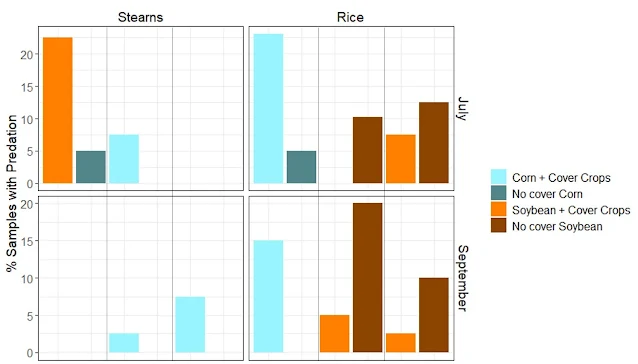By Claire LaCanne, Anna Cates, and Nathan Drewitz
University of Minnesota Extension researchers have started a small trial examining the predation rate of insect pests in differently managed row crop fields. We compared pest predation in row crop fields with cover crops to predation rates in fields without cover crops. Our preliminary results show that more predation took place in corn with cover crops and in soybeans without cover crops (Figure 1). Since corn and soybean fields looked so different, we can’t statistically detect any effect of cover crops at this point.
However, we know that the amount of cover (whether crop residue or cover crop biomass) plays an important role in predator presence, and our results confirm this general principle. Cover was generally greater in corn fields with cover crops. Conversely, soybeans without cover crops had greater canopy cover because they were further along developmentally.
University of Minnesota Extension researchers have started a small trial examining the predation rate of insect pests in differently managed row crop fields. We compared pest predation in row crop fields with cover crops to predation rates in fields without cover crops. Our preliminary results show that more predation took place in corn with cover crops and in soybeans without cover crops (Figure 1). Since corn and soybean fields looked so different, we can’t statistically detect any effect of cover crops at this point.
However, we know that the amount of cover (whether crop residue or cover crop biomass) plays an important role in predator presence, and our results confirm this general principle. Cover was generally greater in corn fields with cover crops. Conversely, soybeans without cover crops had greater canopy cover because they were further along developmentally.
 |
| Figure 1. Predation results from the 2020 sampling dates. Higher predation values means more of the baits were eaten, indicating more presence and activity of ground-dwelling predators. |
Why you want insect predators in your field
In this study, we used wax worms pinned to the soil as bait for predators. These wax worms are representative of soil-dwelling pests, such as cutworms, corn earworm, and potentially some beetle larvae like corn rootworms.During the sampling period, we observed lady beetles, harvestman (commonly called daddy long leg spider), earwigs, slugs, ants, field crickets, tiger beetles, wolf spiders, and other carabid beetles eating the baits, and recorded how many baits had been eaten over the course of an hour.
Ground beetles are generalist predators and eat moth larvae, beetle larvae, mites, and slugs.
Tiger beetles are a type of ground beetle known for their impressive speed. They will eat moth larvae, beetle larvae, ants, and other invertebrates.
Harvestmen are similar to spiders and are scavengers and predators of other arthropods. As omnivores, even crickets will eat other small insects.
These generalist predators can provide a measure of pest management by preying on insect pests, especially ones that may be found on or in the soil. This makes it useful to encourage arthropod diversity in your crop fields.
 |
| Figure 2. Left: Carabid beetle feeding on the entrails of a wax worm. Middle: Carabid beetle feeding on a wax worm. Right: Harvestman feeding on a wax worm. |
How to encourage arthropod diversity in your field
Farmers may think that the only good bug in their crop field is a dead bug. In fact, there are many good insects and other arthropods, commonly known as beneficials, that can actually provide ecosystem services in your crop field. These services include the following:- decomposition
- nutrient cycling
- pollination
- pest management.
In this study we focused on predators, but other soil-dwelling beneficials help out too. Springtails and mites dwell in the soil and help break down crop residue. Earthworms play an important role in nutrient cycling in crop fields.
Stable habitat is important for beneficials both above and within the soil. In general, more arthropods are present on covered ground than on bare soil. Canopy cover and plant residue help provide shelter for insects and other arthropods, and plant residue can also provide overwintering habitat.
Stable habitat is important for beneficials both above and within the soil. In general, more arthropods are present on covered ground than on bare soil. Canopy cover and plant residue help provide shelter for insects and other arthropods, and plant residue can also provide overwintering habitat.
The microclimates provided by winter cover crops (relative to bare soil) are often correlated with increased invertebrate diversity. Minimal soil disturbance has also been correlated with increased invertebrate diversity. Practices such as using cover crops and limiting disturbance through tillage are likely to promote ground-dwelling invertebrates.
Plant diversity itself can also attract predators and parasitoids of herbivore pests. In monoculture settings, the edges of the fields will get greater predator pressure due to diverse adjacent vegetation, like ditches or windbreaks. In-field plant diversity (such as cover crops or a diverse crop rotation) can provide benefits throughout the field.
Plant diversity itself can also attract predators and parasitoids of herbivore pests. In monoculture settings, the edges of the fields will get greater predator pressure due to diverse adjacent vegetation, like ditches or windbreaks. In-field plant diversity (such as cover crops or a diverse crop rotation) can provide benefits throughout the field.
Future work
We’ll be back out at these sites this month to see how the predators are doing in overwintered cover crops or residue. We also plan to repeat this trial on additional fields in 2021. Stay tuned, and get in touch if you find any neat bugs in your cropland!
Comments
Post a Comment